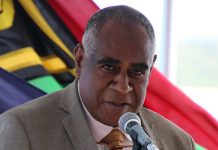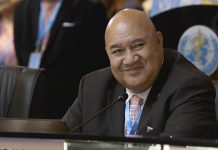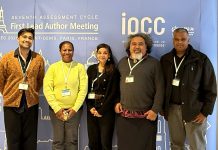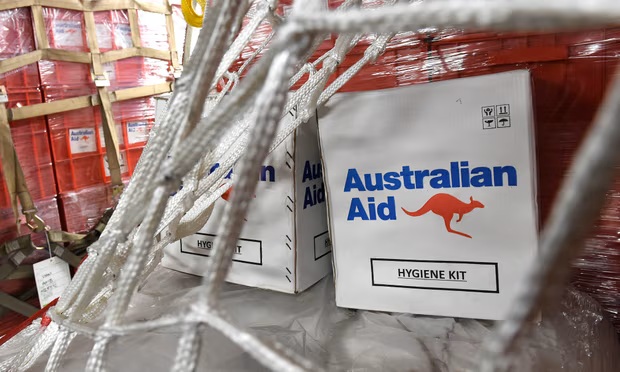Tonga and the Federated States of Micronesia will see notable bumps in Australian foreign aid this year, while analysts say there are some indications that Canberra is stepping in to fill a void left by a U.S freeze on foreign aid.
Overall, Australia announced AUD$5.1 billion (US$3.2 billion) for foreign aid in the 2025-26 budget released Tuesday, a 2.7 percent increase on the previous year, but about flat in real terms.
Pacific island nations were allocated AUD$2.157 billion (US$1.35 billion), up from AUD$2.05 billion (US$1.29 billion) for the 2024-25 financial year, budget documents show.
The region now accounts for about 42 percent of Australian aid, almost doubling from a decade ago and making it the Pacific’s biggest donor, in part as a response to China’s inroads in the region.
In a statement Tuesday, Foreign Minister Penny Wong said in “uncertain times” Australian aid was going to the Pacific and Southeast Asia, “where Australia’s interests are most at stake.”
In the Pacific, the largest aid increases are directed towards the Federated States of Micronesia and Tonga, the latter of which will receive AUD$85 million (US$53.53 million) over the next four years to support its economy.
Tonga’s small and fragile economy is under strain amid looming debt repayment obligations to China of about US$120 million, a sum worth roughly a quarter of its gross domestic economy, according to an analysis by the Lowy Institute.
Assistance to Tonga is part of a broader AUD$296 million (US$186.42 million) package in budget support for Pacific island nations to respond to shocks and bolster economic resilience. A total of AUD$355 million (US$223.58 million) will also be provided over four years on climate resilience projects in Pacific and Southeast Asian countries.
Australia will spend about AUD$81 million (US$51.01 million) over three years on health in the Pacific and Southeast Asia to continue services for HIV and tuberculosis, maternal and child health, family planning, and sexual and reproductive health.
The announcement comes amid widespread fears that U.S. President Donald Trump’s executive order in January to freeze almost all U.S foreign aid would wind back progress made in containing deadly diseases such as tuberculosis (TB) and HIV.
“TB and HIV programs in PNG and Fiji might be affected by the U.S cuts,” said Cameron Hill, a senior research officer at Australian National University’s Development Policy Centre.
“That is an area where I think the government is concentrating some effort and also some civil society programs in the Pacific … which aren’t big in dollar terms, but the U.S. has traditionally played a big role in those,” he said at a panel Wednesday on the budget’s aid component.
Hill said about AUD$120 million (US$75.58 million), or about 2.3 percent of aid spending, had been reprioritised in 2025-26 away from multilateral and global programs.
He added the “unprecedented divergence between defence and development spending is still growing” and will likely rise to a ratio of about 13-1 by the end of the decade.
Canberra announced last year it will spend an additional AUD$50.3 billion (US$31.68 billion) on defence over the next decade.
Australia’s aid budget has held relatively steady amid a global retreat in foreign development assistance, led by the Trump administration’s dismantling of the U.S Agency for International Development (USAID). Trump on 20 January ordered a 90-day programme-by-programme review of which foreign assistance programs deserved to continue.
Robin Davies, an honorary professor at the Development Policy Centre, said about 10 Organisation for Economic Co-operation and Development (OECD) countries – including the three largest the U.S, Germany and Britain — have announced significant cuts to aid volumes over the past year.
He estimated that anywhere from a third to a half of existing aid from OECD sources might disappear within the next few years.
“I think the real impact in our region of the U.S. cuts will be through the weakening of multilateral organisations that we really want to remain in places like Suva, Port Moresby or Jakarta,” he said at the same panel discussion.
Total American aid spending reached US$3.4 billion in the Pacific between 2008-22, according to the Lowy Institute, with most money directed towards the Marshall Islands, Micronesia and Palau.
The three Pacific Island countries give the U.S exclusive military authority in their territories in exchange for economic assistance under compacts of free association.
“About 80 percent of American aid to the Pacific goes to those three countries, and it is still unclear what shape that compact assistance will take in the future,” said Hill.
“The Biden administration signed last year new 20-year compact agreements, but it’s not clear whether the Trump administration will honour those or the new congress will honour those,” he said.














